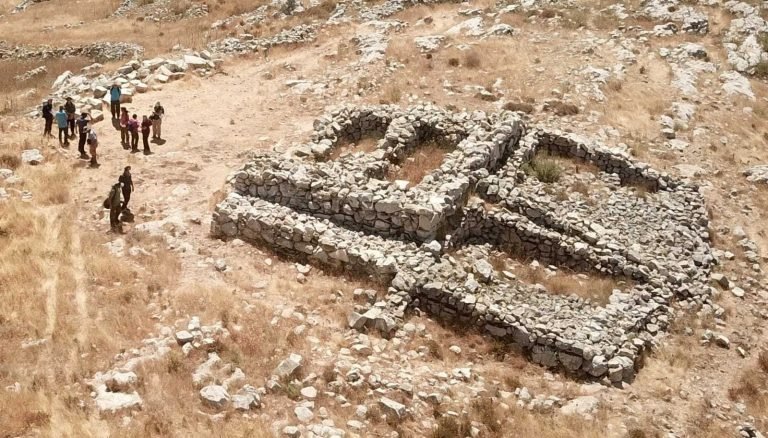Altar on Mount Ebal (photo by zstadler)
The Bible has the following:
1 Now Moses, with the elders of Israel, commanded the people, saying: “Keep all the commandments which I command you today. 2 And it shall be, on the day when you cross over the Jordan to the land which the Lord your God is giving you, that you shall set up for yourselves large stones, and whitewash them with lime. 3 You shall write on them all the words of this law, when you have crossed over, that you may enter the land which the Lord your God is giving you, ‘a land flowing with milk and honey,’ just as the Lord God of your fathers promised you. 4 Therefore it shall be, when you have crossed over the Jordan, that on Mount Ebal you shall set up these stones, which I command you today, and you shall whitewash them with lime. 5 And there you shall build an altar to the Lord your God, an altar of stones; you shall not use an iron tool on them. 6 You shall build with whole stones the altar of the Lord your God, and offer burnt offerings on it to the Lord your God. 7 You shall offer peace offerings, and shall eat there, and rejoice before the Lord your God. 8 And you shall write very plainly on the stones all the words of this law.” (Deuteronomy 27:1-8)
So an altar was supposed to be built.
Since Joshua was the leader of the children of Israel when they crossed over the Jordan, did he have such an altar built?
Yes, The Bible also has the following:
30 Now Joshua built an altar to the Lord God of Israel in Mount Ebal, 31 as Moses the servant of the Lord had commanded the children of Israel, as it is written in the Book of the Law of Moses: “an altar of whole stones over which no man has wielded an iron tool.” (Joshua 8:30-31)
Could it have been found decades ago?
Israel365News reported the following by Aaron Lipkin:
Joshua’s Altar – How Archaeology proves the Bible
March 22, 2023
Since the 1960’s, many historians and Bible scholars (the “Minimalists”) suggested that the Bible is not a history book and that the events described in the Old Testament, never really happened or are at best, inaccurate. They claimed the Exodus and the Conquest never occurred, Moses and Joshua never really existed. Why did they come to that conclusion? Because of “lack of archaeological proof”, they claim.
In 1982, a young secular Israeli archaeologist by the name of Adam Zertal started excavating an ancient archaeological site on Mt. Ebal, near the Biblical city of Shechem in the region of Samaria, Israel. He dated the structure to the Early Iron Age (1250 BC). https://www.israel365news.com/368740/joshuas-altar-how-archaeology-proves-the-bible/
As far as the dating of the altar itself goes, while there are some broken pots that date into the 13th century BCE, the rocks themselves are not dated. If this is the altar that Joshua built, it would have been built about 150 years earlier–somewhere in the 1400-1370 BCE date. That said, Adam Zertal presented a 1985 study where he believed he was able to prove that there were different stages during the site’s development and that critics who did not believe this could be Joshua’s altar overlooked evidence (e.g. https://www.baslibrary.org/biblical-archaeology-review/12/1/2). As far as the Exodus goes, here is a link related to that: When was the Exodus? Did it Happen?
Now, initially, Adam Zertal had not believed he had found what could be Joshua’s altar. Yet by 1985, his views changed after studying more archeological data. Let’s continue with Aaron Lipkin’s Israel365News article related to him:
Like the Minimalist scholars, Zertal did not believe that the book of Deuteronomy and the book of Joshua describe real historical events, but he was intrigued by this mysterious heap of stones and the surrounding enclosure wall. …
Zertal tried to find the origin of this mysterious structure and was not able to find any architectural parallels in the Canaanite and surrounding cultures. One day an Orthodox Jew showed him a sketch of the Second Temple Altar…the similarity was striking.
Zertal understood that he’d found an Israelite altar on Mt. Ebal. In his book “A Nation Born” he describes how he looked at the Orthodox Jew and said, “This has to be the altar that Joshua built according to the commandment of Moses. There is no other possibility. If this is Joshua’s Altar, then Joshua existed, and Moses existed and the Exodus really happened…” From that point on, Zertal believed in the historicity of the Biblical account.
So, Adam Zertal believed the evidence he uncovered.
The Israel365News article then had the following related to more recent research by Aaron Lipkin who wrote:
In 2019, I was involved in a special expedition of archaeologists that came to Israel to reanalyze the archaeological dump from Zertal’s 1980’s excavations.
We extracted the material and by using a wet sifting technique, we were able to locate findings that Zertal missed. …
Archaeologist Dr. Scott Stripling announced that the tablet contained what is probably the most ancient Hebrew inscription ever found in the Land of Israel.
The inscription was a curse, written in Hebrew, with the name of the Lord engraved in it:
You are Cursed by the God YHW, Cursed.
You will die Cursed – Cursed you will surely die.
Cursed you are by YHW – Cursed.
This is probably the most important inscription ever found in the land of Israel. …
Moses commanded the Israelites to conduct a national ceremony and proclaim the Curses on Mt. Ebal and the Blessings on Mt. Gerizim.
“And when the Lord your God brings you into the land that you are entering to take possession of it, you shall set the blessing on Mount Gerizim and the curse on Mount Ebal.” Deuteronomy 11:29 (ESV)
Is it possible we found a curse inscription on the mountain of Curses, related to the ceremony mentioned in the Bible?
Yes, there looks to be ties of this archaeological site and the Bible.
That said, there is also more archaeological evidence about Joshua.
For example, last August, the Temple Institute had the following in its newsletter:
Av 29, 5782/August 26, 2022 …
First Archaeological Dig Begins At Site Believed To Be Joshua’s Tomb “And Joshua sent the people away, every man to his inheritance. And it was after these things, that Joshua the son of Nun, the servant of HaShem, died, being a hundred and ten years old. And they buried him in the border of his inheritance in Timnat-serah, which is in Mount Ephraim, on the north side of the hill of Gaash. And Israel served HaShem all the days of Joshua, and all the days of the elders that outlived Joshua, and who had known all the works of HaShem, that He had done for Israel.” (Joshua 24:28-31) Khirbet Tibnah is located on a hill in the southwest of the Samaria region, east of Shoham near Halamish. The site was populated from the Bronze Age until the beginning of the Ottoman period.
The Temple Institute had more on this at its Facebook page:
Khirbet Tibnah is located on a hill in the southwest of the Samaria region, east of Shoham near Halamish. The site was populated from the Bronze Age until the beginning of the Ottoman period.
Archaeologists have begun digging at Khirbet Tibnah in the West Bank, a site where humans have settled for about 4,000 years and which is believed to be where the biblical Joshua lived and was buried, the excavation project at the site announced on Monday.
The dig is being led by Dr. Dvir Raviv and students from Bar-Ilan’s Department of Land of Israel Studies and Archaeology, alongside volunteers from Israel and abroad.
Khirbet Tibnah is located on a hill in the southwest of the Samaria region, east of Shoham near Halamish. The site was populated from the Bronze Age until the beginning of the Ottoman period, according to Bar-Ilan.
The site is also identified as Timnath-heres or Timnath-serah, a town which, according to the Book of Joshua, was given by the Israelites to the prophet and was where he lived and was buried. The tomb of Caleb is also believed to be at the site.
The site was surveyed in the 1800’s and is mentioned in a number of historical documents. https://www.facebook.com/templeinstitute/posts/10151729391479969
Here is some of what the Bible tells about Joshua and his burial:
29 Now it came to pass after these things that Joshua the son of Nun, the servant of the Lord, died, being one hundred and ten years old. 30 And they buried him within the border of his inheritance at Timnath Serah, which is in the mountains of Ephraim, on the north side of Mount Gaash.
31 Israel served the Lord all the days of Joshua, and all the days of the elders who outlived Joshua, who had known all the works of the Lord which He had done for Israel.
32 The bones of Joseph, which the children of Israel had brought up out of Egypt, they buried at Shechem, in the plot of ground which Jacob had bought from the sons of Hamor the father of Shechem for one hundred pieces of silver, and which had become an inheritance of the children of Joseph.
33 And Eleazar the son of Aaron died. They buried him in a hill belonging to Phinehas his son, which was given to him in the mountains of Ephraim. (Joshua 24:29-33)
This is interesting as we get closer to the end that some archeologists continue to look for more evidence of biblical locations, figures, and events.
Now notice the following from Robert M. Bowman, Jr.:
I will highlight three pieces of evidence that support the historicity of the account found in the Old Testament.
(1) The list of cities in the Transjordan region through which the Israelites passed on their way into the land in Numbers 33:45-50 includes Iyim, Dibon-gad, Abel-shittim, and Jordan. A list of places through which Egyptian armies passed in their military incursions dating from the same general period include these four places in the same order. Ian Wilson in his book The Bible Is History quotes archaeologist Charles Krahmalkov on this point: “The biblical story of the invasion of Transjordan that sets the stage for the conquest of all Palestine is told against a background that is historically accurate. The Israelite invasion route described in Numbers 33:50 was…an official, heavily trafficked Egyptian road through the Transjordan in the Late Bronze Age.”3 By itself, this piece of information does not prove that the Conquest happened, but it does lend some credibility to the account.
(2) Although most archaeologists today think that the story of Joshua’s conquest of Jericho cannot be true, their reasoning is likely based on a mistaken chronology. As Time magazine recently put it, “Did Joshua conquer the city of Jericho? The walls of this Canaanite city did come tumbling down, say most historians, but centuries before Moses’ protégé could have arrived.”4 This assessment is based on the conclusions of Kathleen Kenyon, who in the 1950s dated Jericho’s fall to around 1500 BC while assuming a late date of around 1200 BC for the Conquest. The issue here, then, is one of chronology. The bottom line is that “the walls” did, in fact, “come a tumblin’ down,” just as the Bible says, although the current archaeological convention does not date the event to the period indicated by the Bible. Similar chronological difficulties attend the events of the Exodus: there are records of Egypt being devastated by the kinds of plagues recorded in the Book of Exodus, but modern archaeology dates this devastation to a period hundreds of years earlier than the Bible indicates.5 One should not underestimate the extreme complexities and difficulties of calibrating archaeological finds across the region with the chronological information found in ancient written sources.
(3) Scientists have discovered evidence that provides remarkable confirmation of one of the miracles of the Conquest: the crossing of the Jordan River. The book of Joshua reports that when the Israelites began to cross the Jordan opposite Jericho, the waters of the Jordan “rose up in one heap a great distance away at Adam” as they flowed down toward the Dead Sea (Josh. 3:14-17). This damming of the river allowed the Israelites to walk across the riverbed on dry ground. Critics of the Bible routinely claim that no such event occurred, and suggest that the book is crediting Joshua with a miracle similar to the crossing of the Red Sea in order to portray him as Moses’ true successor. However, we have good evidence, both internal and external, supporting the historicity of the account of Joshua’s crossing of the Jordan.
Adam was a village some fifteen or twenty miles upstream (north) from where the Israelites crossed the river. (They crossed directly across from Jericho.) There is nothing historically or religiously significant about this village other than its role as a “footnote” in this account that would explain why the book of Joshua specifies it as the place where the waters were stopped. Furthermore, a writer composing a “pious fiction” about Joshua stopping the waters of the Jordan would surely have had the waters stop right in front of the Israelites, not miles upstream. This incidental detail clearly indicates that the story is at least based on fact. https://www.namb.net/apologetics/resource/joshua-s-conquest-did-it-happen/ accessed 08/26/22
Of course, for those of us who believe the Bible, no further proof related to Joshua is needed. But for some who have heard statements from pseudo-archaeologists that deny the biblical accounts, it may be helpful for them to realize that as time goes on, more and more archaeological evidence surfaces that supports the Bible.
Many of the so-called educated have claimed many fraudulent positions, like that the biblical David was a myth. Now, notice the following:
Here is a link to that July-September 2017 edition of Bible News Prophecy magazine. Its front cover shows an ancient stela that mentions King David, and contains more information about why true science supports the Bible. In 2023, its incscription was declared to be genuine (see Mesha Stela declared to mention ‘House of David,’ hence is additional proof of the biblical text)–of course, that means it was also genuine in 2017 and before.
The Bible is true, but many do not want it to be believed.
The world’s claimed anti-biblical knowledge is false.
The Apostle Paul warned:
20 … Guard what was committed to your trust, avoiding the profane and idle babblings and contradictions of what is falsely called knowledge — 21 by professing it some have strayed concerning the faith. (1 Timothy 6:20-21)
Be careful not to accept ‘knowledge’ from those who are contradicting the Bible.
Notice also:
9 The coming of the lawless one is according to the working of Satan, with all power, signs, and lying wonders, 10 and with all unrighteous deception among those who perish, because they did not receive the love of the truth, that they might be saved. 11 And for this reason God will send them strong delusion, that they should believe the lie, 12 that they all may be condemned who did not believe the truth but had pleasure in unrighteousness. 92 Thessalonians 2:9-12)
Do you really love the truth?
Then do not fall for their lies.
Remember to “let God be true but every man a liar” (Romans 3:4).
There was a Joshua and some are looking for even more evidence to prove that is so.
Related to Joshua and skeptics, we put together the following video:
16:34
Did Joshua of the Bible Exist?
The Temple Institute out of Jerusalem reported that the first archaeological dig has started at the site many believe was the tomb of Joshua of the Bible. What does the Bible say about Joshua’s burial? Why do places like Wikipedia and Google point to sources who say that Joshua did not exist, but instead was a national myth? Are they looking at the wrong time (13th instead of 15th century BCE)? What about archaeological evidence that points to place the Book of Judges mentions? What about the destruction of ancient Jericho? Should we trust the biblical account or those who claim to have scholarly knowledge? Steve Dupuie and Dr. Thiel go over these matters.
Here is a link to the video: Did Joshua of the Bible Exist?
Related Items:
Exodus Sermon Series
When was the Exodus? Did it Happen?
Reasons, Proofs, and Ramifications of the Ten Plagues of Exodus
Egypt and the Plagues (Part 1)
Exodus Plagues and Prophecy (Part 2).
Exodus and the Days of Unleavened Bread
Exodus 4:24, Why would God have sought to kill Moses?
Is God’s Existence Logical?
Is it logical to believe in God?
A Lifegiver or Spontaneous Evolution?
Evolution is NOT the Origin of Life
Is It Logical And Scientific To Believe In God?
Tradition and Scripture: From the Bible and Church Writings
Sermons related to the free online book above:
The Old Testament Canon: Who Knew?
The Books of the Old Testament
The Septuagint and its Apocrypha
Masoretic Text of the Old Testament
Let's Talk About the New Testament
The New Testament Canon From the Beginning
English Versions of the Bible and How Did We Get Them?
Original Order of the Books of the Bible
What was the Original Language of the New Testament?
Who Gave the World the Bible? Who Had the Chain of Custody?
Click here for current news and analysis as well as literature in over 120 languages
Click here for free online books and booklets in the English language.
Information on broadcast times for the European Gospel Radio /Short Wave Radio, AM/FM and other radio stations: Radio Stations
LATEST NEWS REPORTS
LATEST BIBLE PROPHECY ITEMS



























